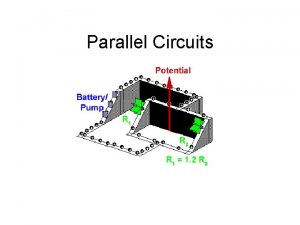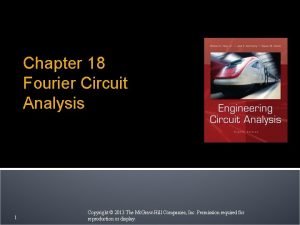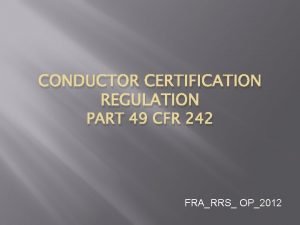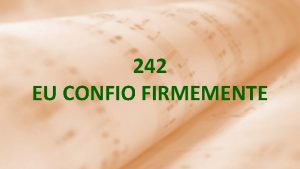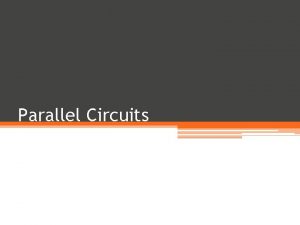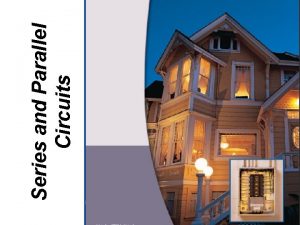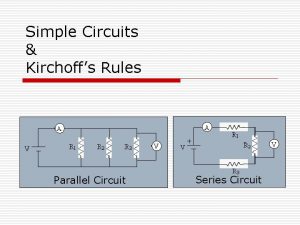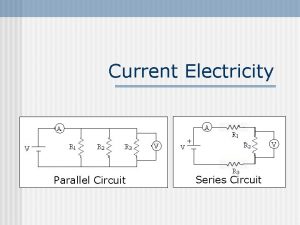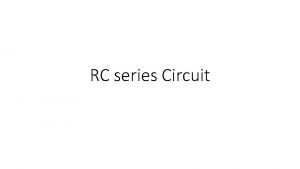ET 242 Circuit Analysis II Series Parallel AC














- Slides: 14

ET 242 Circuit Analysis II Series & Parallel AC Circuits Analysis Electrical and Telecommunication Engineering Technology Professor Jang

Acknowledgement I want to express my gratitude to Prentice Hall giving me the permission to use instructor’s material for developing this module. I would like to thank the Department of Electrical and Telecommunications Engineering Technology of NYCCT for giving me support to commence and complete this module. I hope this module is helpful to enhance our students’ academic performance.

OUTLINES Ø Introduction to Series - Parallel ac Circuits Analysis Ø Reduction of series parallel Circuits to Series Circuits Ø Analysis of Ladder Circuits Key Words: ac Circuit Analysis, Series Parallel Circuit, Ladder Circuit ET 242 Circuit Analysis II – Series-Parallel Circuits Analysis Boylestad 2

Series & Parallel ac Networks - Introduction In general, when working with series-parallel ac networks, consider the following approach: 1. Redraw the network, using block impedances to combine obvious series and parallel elements, which will reduce the network to one that clearly reveals the fundamental structure of the system. 2. Study the problem and make a brief mental sketch of the overall approach you plan to use. In some cases, a lengthy, drawn-out analysis may not be necessary. A single application of a fundamental law of circuit analysis may result in the desired solution. 3. After the overall approach has been determined, it is usually best to consider each branch involved in your method independently before tying them together in series-parallel combinations. In most cases, work back from the obvious series and parallel combinations to the source to determine the total impedance of the network. 4. When you have arrived a solution, check to see that it is reasonable by considering the magnitudes of the energy source and the elements in the circuit. ET 242 Circuit Analysis II – Series-Parallel Circuits Analysis Boylestad 3

Ex. 16 -1 For the network in Fig. 16. 1: a. Calculate ZT. b. Determine Is. e. Compute the power delivered. c. Calculate VR and VC. d. Find IC. f. Find Fp of the network. Figure 16. 2 Network in Fig. 16. 1 after assigning the block impedances. Figure 16. 1 Example 16. 1. a. As suggested in the introduction, the network has been redrawn with block impedances, as shown in Fig. 16. 2. Impedance Z 1 is simply the resistor R of 1Ω, and Z 2 is the parallel combination of XC and XL. ET 242 Circuit Analysis II – Series-Parallel Circuits Analysis Boylestad 12

ET 242 Circuit Analysis II – Series-Parallel Circuits Analysis Boylestad 5

Ex. 16 -2 For the network in Fig. 16. 3: a. If I is 50 A∟ 30 o, calculate I 1 using the current divider rule. b. Repeat part (a) for I 2. c. Verify Kirchhoff’s current law at one node. Figure 16. 3 Example 16. 2. Figure 16. 4 Network in Fig. 16. 3 ET 242 Circuit Analysis II – Parallel ac circuits analysis Boylestad after assigning the block impedances. 6

Ex. 16 -3 For the network in Fig. 16. 5: a. Calculate the voltage VC using the voltage divider rule. b. Calculate the current Is. Figure 16. 6 Network in Fig. 16. 5 after assigning the block impedances. Figure 16. 5 Example 16. 3. ET 242 Circuit Analysis II – Parallel ac circuits analysis Boylestad 2

Ex. 16 -4 For Fig. 16. 7: a. Calculate the current Is. b. Find the voltage Vab. Figure 16. 7 Example 16. 4. Figure 16. 8 Network in Fig. 16. 7 after assigning the block impedances. ET 242 Circuit Analysis II – Series-Parallel Circuits Analysis Boylestad 8

Ex. 16 -6 For the network in Fig. 16. 12: a. Determine the current I. b. Find the voltage V. Figure 16. 12 Example 16. 6. a. The equivalent current source is their sum or difference (as phasors). Figure 16. 8 ET 242 Circuit Analysis II – Series-Parallel Circuits Analysis Boylestad 9

Ex. 16 -7 For the network in Fig. 16. 14: a. Compute I. b. Find I 1, I 2, and I 3 c. Verify KCL by showing that I = I 1 + I 2 + I 3. d. Find total impedance of the circuit; . Figure 16. 14 Example 16. 7. Figure 16. 15 Network in Fig. 16. 14 following the assignment of the subscripted impedances. ET 242 Circuit Analysis II – Parallel ac circuits analysis Boylestad 10

Ex. 16 -8 For the network in Fig. 16. 18: a. Calculate the total impedance ZT. Compute I. c. Find the total power factor. d. Calculate I 1 and I 2. Find the average power delivered to the circuit. Figure 16. 19 Network in Fig. 16. 14 following the assignment of the subscripted impedances. Figure 16. 18 Example 16. 8. ET 242 Circuit Analysis II – Parallel ac circuits analysis b. e. Boylestad 11

ET 242 Circuit Analysis II – Series-Parallel Circuits Analysis Boylestad 12

Ladder Networks Ladder networks were discussed in some detail in Chapter 7. This section will simply apply the first method described in Section 7. 6 to the general sinusoidal ac ladder network in Fig. 16. 22. The current I 6 is desired. Figure 16. 22 Ladder network. Figure 16. 23 Defining an approach to the analysis of ladder networks. ET 242 Circuit Analysis II – Parallel ac circuits analysis Boylestad 13
 Series circuit vs parallel circuit
Series circuit vs parallel circuit Types of circuit
Types of circuit Series vs parallel circuit
Series vs parallel circuit Reflection and refraction venn diagram
Reflection and refraction venn diagram Advantages of parallel circuits over series circuit
Advantages of parallel circuits over series circuit Short circuit circuit diagram
Short circuit circuit diagram Difference between series and parallel circuit
Difference between series and parallel circuit Parallel circuit examples
Parallel circuit examples Draw a series circuit
Draw a series circuit Phet circuit construction kit
Phet circuit construction kit Fourier series circuit analysis
Fourier series circuit analysis Kj242
Kj242 Gezang 242
Gezang 242 49 cfr part 242
49 cfr part 242 Eu confio firmemente que no céu vou descansar
Eu confio firmemente que no céu vou descansar







